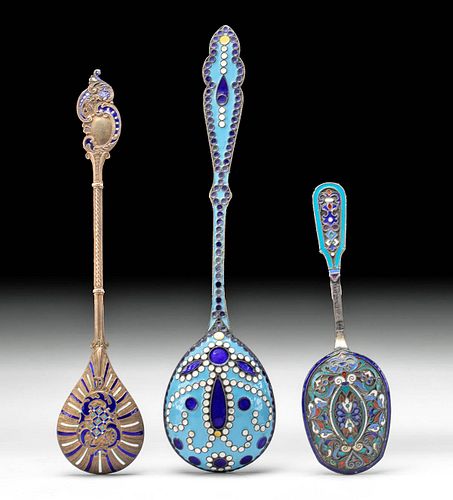19th C. Russian & Danish Cloisonne Silver Spoons (3)
Lot 327
About Seller
Artemis Gallery
686 S Taylor Ave, Ste 106
Louisville, CO 80027
United States
Selling antiquities, ancient and ethnographic art online since 1993, Artemis Gallery specializes in Classical Antiquities (Egyptian, Greek, Roman, Near Eastern), Asian, Pre-Columbian, African / Tribal / Oceanographic art. Our extensive inventory includes pottery, stone, metal, wood, glass and textil...Read more
Estimate:
$800 - $1,200
Absentee vs Live bid
Two ways to bid:
- Leave a max absentee bid and the platform will bid on your behalf up to your maximum bid during the live auction.
- Bid live during the auction and your bids will be submitted real-time to the auctioneer.
Bid Increments
| Price | Bid Increment |
|---|---|
| $0 | $25 |
| $300 | $50 |
| $1,000 | $100 |
| $2,000 | $250 |
| $5,000 | $500 |
| $10,000 | $1,000 |
| $20,000 | $2,500 |
| $50,000 | $5,000 |
| $100,000 | $10,000 |
| $200,000 | $20,000 |
About Auction
By Artemis Gallery
Sep 16, 2021
Set Reminder
2021-09-16 10:00:00
2021-09-16 10:00:00
America/New_York
Bidsquare
Bidsquare : Ancient & Ethnographic Art Through The Ages
https://www.bidsquare.com/auctions/artemis-gallery/ancient-ethnographic-art-through-the-ages-7473
Ancient art from Egypt, Greece, Italy and the Near East, as well as Asian, Fossils, Pre-Columbian, Native American, African / Tribal / Oceanic, Fine art, and much more! All categories, all price ranges... all legally acquired and guaranteed to be as described or your money back. Artemis Gallery info@artemisgallery.com
Ancient art from Egypt, Greece, Italy and the Near East, as well as Asian, Fossils, Pre-Columbian, Native American, African / Tribal / Oceanic, Fine art, and much more! All categories, all price ranges... all legally acquired and guaranteed to be as described or your money back. Artemis Gallery info@artemisgallery.com
- Lot Description
Eastern Europe, Russia, ca. 19th to 20th century CE; Denmark, ca. late 19th to early 20th century CE. A fine trio of antique silver and enamel spoons. The first two are Russian style cloisonne. The largest is a dining spoon with a rounded bowl that is gilded with 24% gold over the 71.5% silver. The verso and handle are decorated with a blue cloisonne surrounded dotted white, cobalt, and yellow patterns. The side of the neck is stamped with 3 marks: a silver purity mark "84" to the left of the city mark of Moscow, and the assayer mark "HA." The other is a 91% silver sugar spoon with a spade shaped bowl, also decorated with colorful foliate cloisonne. The handle is marked with 4 stamps: the first is the maker and the year "1893," the silver purity mark "84," and other indiscernible marks. The final spoon is likely from Denmark and has 3 markings on the neck and lovely enamel in blue and white. Size of largest spoon: 6.875" L x 1.75" W (17.5 cm x 4.4 cm); silver quality of all three: 71.5% to 91%; gold quality: up to 24%; total weight: 102 grams
Provenance: ex-collection of James Farmer, Maryland, USA, collected from major galleries and auction houses between 1995 and 2005
All items legal to buy/sell under U.S. Statute covering cultural patrimony Code 2600, CHAPTER 14, and are guaranteed to be as described or your money back.
A Certificate of Authenticity will accompany all winning bids.
PLEASE NOTE: Due to recent increases of shipments being seized by Australian & German customs (even for items with pre-UNESCO provenance), we will no longer ship most antiquities and ancient Chinese art to Australia & Germany. For categories of items that are acceptable to ship to Australia or Germany, please contact us directly or work with your local customs brokerage firm.
Display stands not described as included/custom in the item description are for photography purposes only and will not be included with the item upon shipping.
#163643Dark toning and cleanable patina on all three. Nicks and chips to cloisonne on sugar spoon and the maker marks are soft and partially illegible. The large spoon is very good with some dark patina and minor surface wear, the cloisonne is very good. The maker marks are soft but discernable.Condition
- Shipping Info
-
All shipping is handled in-house for your convenience. Your invoice from Artemis Gallery will include shipping calculation instructions. If in doubt, please inquire BEFORE bidding for estimated shipping costs for individual items.
-
- Buyer's Premium



 EUR
EUR CAD
CAD AUD
AUD GBP
GBP MXN
MXN HKD
HKD CNY
CNY MYR
MYR SEK
SEK SGD
SGD CHF
CHF THB
THB













